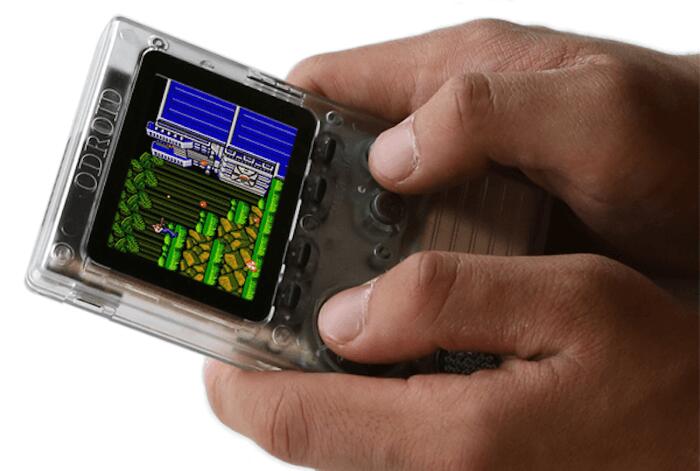ODROID-GO
Overview
ODROID-GO Game Kit is a “Do it yourself” (“DIY”) portable game console by HardKernel. It features a custom ESP32-WROVER with 16 MB flash and it operates from 80 MHz - 240 MHz [1].
The features include the following:
Dual core Xtensa microprocessor (LX6), running at 80 - 240MHz
4 MB of PSRAM
802.11b/g/n/e/i
Bluetooth v4.2 BR/EDR and BLE
2.4 inch 320x240 TFT LCD
Speaker
Micro SD card slot
Micro USB port (battery charging and USB_UART data communication
Input Buttons (Menu, Volume, Select, Start, A, B, Direction Pad)
Expansion port (I2C, GPIO, SPI)
Cryptographic hardware acceleration (RNG, ECC, RSA, SHA-2, AES)

ODROID-Go Game Kit
External Connector
PIN # |
Signal Name |
ESP32-WROVER Functions |
|---|---|---|
1 |
GND |
GND |
2 |
VSPI.SCK (IO18) |
GPIO18, VSPICLK |
3 |
IO12 |
GPIO12 |
4 |
IO15 |
GPIO15, ADC2_CH3 |
5 |
IO4 |
GPIO4, ADC2_CH0 |
6 |
P3V3 |
3.3 V |
7 |
VSPI.MISO (IO19) |
GPIO19, VSPIQ |
8 |
VSPI.MOSI (IO23) |
GPIO23, VSPID |
9 |
N.C |
N/A |
10 |
VBUS |
USB VBUS (5V) |
Supported Features
The Zephyr odroid_go board configuration supports the following hardware features:
Interface |
Controller |
Driver/Component |
|---|---|---|
UART |
on-chip |
serial port |
GPIO |
on-chip |
gpio |
PINMUX |
on-chip |
pinmux |
I2C |
on-chip |
i2c |
SPI |
on-chip |
spi |
System requirements
Prerequisites
Espressif HAL requires WiFi and Bluetooth binary blobs in order work. Run the command below to retrieve those files.
west blobs fetch hal_espressif
Note
It is recommended running the command above after west update.
Building & Flashing
ESP-IDF bootloader
The board is using the ESP-IDF bootloader as the default 2nd stage bootloader. It is build as a subproject at each application build. No further attention is expected from the user.
MCUboot bootloader
User may choose to use MCUboot bootloader instead. In that case the bootloader must be build (and flash) at least once.
There are two options to be used when building an application:
Sysbuild
Manual build
Note
User can select the MCUboot bootloader by adding the following line
to the board default configuration file.
`
CONFIG_BOOTLOADER_MCUBOOT=y
`
Sysbuild
The sysbuild makes possible to build and flash all necessary images needed to bootstrap the board with the ESP32 SoC.
To build the sample application using sysbuild use the command:
west build -b odroid_go --sysbuild samples/hello_world
By default, the ESP32 sysbuild creates bootloader (MCUboot) and application images. But it can be configured to create other kind of images.
Build directory structure created by sysbuild is different from traditional Zephyr build. Output is structured by the domain subdirectories:
build/
├── hello_world
│ └── zephyr
│ ├── zephyr.elf
│ └── zephyr.bin
├── mcuboot
│ └── zephyr
│ ├── zephyr.elf
│ └── zephyr.bin
└── domains.yaml
Note
With --sysbuild option the bootloader will be re-build and re-flash
every time the pristine build is used.
For more information about the system build please read the Sysbuild (System build) documentation.
Manual build
During the development cycle, it is intended to build & flash as quickly possible. For that reason, images can be build one at a time using traditional build.
The instructions following are relevant for both manual build and sysbuild. The only difference is the structure of the build directory.
Note
Remember that bootloader (MCUboot) needs to be flash at least once.
Build and flash applications as usual (see Building an Application and Run an Application for more details).
# From the root of the zephyr repository
west build -b odroid_go samples/hello_world
The usual flash target will work with the odroid_go board
configuration. Here is an example for the Hello World
application.
# From the root of the zephyr repository
west build -b odroid_go samples/hello_world
west flash
Open the serial monitor using the following command:
west espressif monitor
After the board has automatically reset and booted, you should see the following message in the monitor:
***** Booting Zephyr OS vx.x.x-xxx-gxxxxxxxxxxxx *****
Hello World! odroid_go
Debugging
As with much custom hardware, the ESP32 modules require patches to OpenOCD that are not upstreamed yet. Espressif maintains their own fork of the project. The custom OpenOCD can be obtained at OpenOCD ESP32 [2]
The Zephyr SDK uses a bundled version of OpenOCD by default. You can overwrite that behavior by adding the
-DOPENOCD=<path/to/bin/openocd> -DOPENOCD_DEFAULT_PATH=<path/to/openocd/share/openocd/scripts>
parameter when building.
Here is an example for building the Hello World application.
# From the root of the zephyr repository
west build -b odroid_go samples/hello_world -- -DOPENOCD=<path/to/bin/openocd> -DOPENOCD_DEFAULT_PATH=<path/to/openocd/share/openocd/scripts>
west flash
You can debug an application in the usual way. Here is an example for the Hello World application.
# From the root of the zephyr repository
west build -b odroid_go samples/hello_world
west debug
